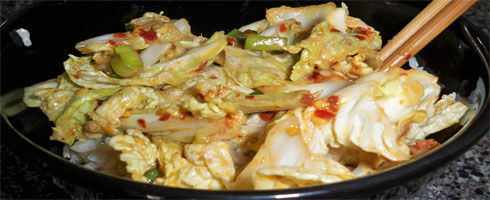Kimchi Recipe
22 Apr

Kimchi Recipe: Kimchi are traditional Korean pickled dishes with various seasonings. You won’t be disappointed with this Kimchi recipe, it is our favorite, even in comparison to those made at Korean restaurants! There are many different variations of kimchi that are dependent on region and often season by what is available. This is a basic kimchi recipe, that is not made the traditional way, but one that is easily made and tastes every bit as delicious. I do not use fish paste in my recipe (just not that big of a fan), however, if you prefer to have that in your kimchi it can be easily added in.
The most common type of kimchi is very spicy, and usually served as a side dish. However, you can also add kimchi with other ingredients to make dishes such as, kimchi stew or kimchi fried rice. Kimchi varieties are determined by the main vegetable ingredients and the mix of seasonings used to flavor the kimchi. The most popular type of kimchi is the baechu (also known as Chinese cabbage) variety but there are many regional and seasonal varieties. Popular variants include Ggakdugi which is a kimchi made with cubed radish, pa-kimchi (made with scallion), chonggak-kimchi and oisobagi, and gat-kimchi, boochoo-kimchi, a cumcumber kimchi with hot and spicy seasoning.
Kimchi is very spicy and can also be exceptionally sweet. Kimchi is made of various vegetables and contains a high concentration of dietary fiber, while being low in calories. One serving also provides up to 80% of the daily recommended amount of vitamin C, and carotene. Most types of kimchi contain onions, garlic, and peppers, all of which are salutary. The vegetables being made into kimchi also contribute to the overall nutritional value. Kimchi is rich in vitamin A, thiamine (B1), riboflavin (B2), calcium, and iron, and contains a number of lactic acid bacteria, among those the typical species Lactobacillus kimchii.
There are many different variations of kimchi that are dependent on region and often season by what is available. This is a basic kimchi recipe, that is not made the traditional way, but one that is easily made and tastes every bit as delicious. I do not use fish paste in my recipe (just not that big of a fan), however, if you prefer to have that in your kimchi it can be easily added in.
Kimchi Recipe
1 head Napa cabbage, chopped
4 green onions, thinly sliced
¼ cup rice wine vinegar
1 tablespoon soy sauce
1 (1 inch) piece fresh ginger, peeled and chopped
4 cloves garlic, chopped
¼ cup red chili flakes, plus more to taste
1 tablespoon sugar
¼ cup vegetable oil
Salt and freshly ground pepper
Place cabbage and green onions in a large bowl. In a blender, combine vinegar, soy sauce, ginger, chili flakes, and sugar, blending until smooth. With the motor running, slowly add the oil. Season with salt and pepper, to taste. Pour the dressing over the cabbage and gently toss. Cover and refrigerate for 2 to 3 days before serving to let the cabbage wilt and the flavors meld.




Best post yet. I am interested by all types of asian cooking. I just found an asian market by my house and want to try more recipes using the ingredients from there.
I’ll definitely make this.
Well, what a delicious and easy idea for a recipe! My appreciation to you and keep em coming!
I would contact some of the organic garlic seed suppliers such as Gourmet Garlic Gardens or Filaree Farms and network with them to see if they can offer any good sources for bulk quantities of shallot seed. They may also be able to point you in the direction of other shallot growers, suppliers